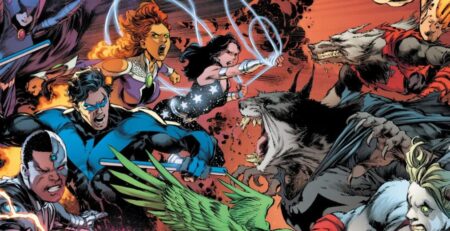
Radiant Black #4 is written by Kyle Higgins, illustrated and colored by Marcelo Costa, and lettered by Becca Carey, with Michael Busuttil serving as series editor and designer. It is published by Image Comics. Plagued by strange dreams involving a giant robot that speaks to him, Nathan Burnett enlists the help of his friend Marshall to gain a greater grasp on his powers. Unfortunately, trouble strikes when the red-suited thief from Radiant Black #2 attacks Nathan, leading to a battle across all of Illinois.
This issue is titled “Everything Changes,” and I can say without hyperbole, the issue more than lives up to its title. The ending hits like a gut punch. I never saw it coming, but it fundamentally alters the course of the series and promises to keep up the same caliber of storytelling. Higgins is no stranger to creating world-shaking twists in his books, with Mighty Morphin Power Rangers and The Rise of Ultraman being key examples. And unlike other twists that seem to be thrown in purely for the sake of shock value, Higgins’ makes sense within the story’s set-up.
Higgins also tackles another Toku trope with the appearance of a massive robot that communicates with Nathan in his dreams. Unlike the Power Rangers’ Megazords or the lions that form Voltron, this robot is sentient and can speak, and the message it bears is rather unsettling. Another trope is the ever-present “superhero’s best friend is in on their secret/helps them train,” which is given a new spin with how Nathan and Marshall approach Nathan’s powers. Nathan struggles to get a handle on his powers and doesn’t seem to be fully committed to the superhero life. At the same time, Marshall utterly embraces it, even coaching Nathan to expand his gravity powers further and push him to embrace superheroism.
Costa also levels up his art with “Everything Changes,” especially the fight sequences. A page features Nathan grabbing the red-suited thief with his powers and literally bouncing him off buildings. Another page features the red-suited thief slamming Nathan through a building, with Costa drawing a cross-section of the ensuing damage. Costa’s art takes a psychedelic, more trippy turn in the sequences where Nathan communes with the giant robot. In addition to sporting multiple colors, the art is drawn as though it’s out of sync with the real world-which adds to the otherworldliness of the dream sequence.
The issue also contains two backup stories, each focused on Marshall. “Marshall’s School of Business” features writing from Riley Trella and Melissa Flores with artwork from Eduardo Ferigato (with Costa on colors) and Joe Hunter. They feature Marshall attempting to launch a “get rich quick” scheme-which includes an app that explains movies to the viewer’s girlfriend and a newspaper for kidnappers. As you’d expect from a character of Marshall’s temperament, these strips are quite hilarious, especially the second one, as Hunter’s art has a Scott Pilgrim-esque quality to it. I wouldn’t mind seeing more of these backups in the future or an entire issue in the same vein as Radiant Black #3.
Radiant Black #4 features a shocking plot twist that fundamentally changes the nature of the series and cements the series as one of the most innovative superhero comics published today. Now that the series has taken this radical shift, I can’t wait to see how it affects the book going forward and where Higgins and Costa take things from here.
Radiant Black #4 is available now wherever comics are sold.
Radiant Black #4
TL;DR
Radiant Black #4 features a shocking plot twist that fundamentally changes the nature of the series and cements the series as one of the most innovative superhero comics published today. Now that the series has taken this radical shift, I can’t wait to see how it affects the book going forward and where Higgins and Costa take things from here.




